C-Suite Dynamics: CEO vs COO vs CIO vs CTO – Key Differences
 11 August 2024
11 August 2024🔊 Listen to the Summary of this article in Audio
In the last five years, 80% of CEOs have added a top-level exec to their team, often referred to as a c-level position. As companies grow, the roles of their highest leaders get more complex. CEOs, COOs, CIOs, and CTOs are crucial for guiding their firms to success, with some of these senior executives reporting directly to the CEO.
The ‘C-suite’ refers to the top execs in a company, each bringing their own skills. The CEO sets the overall direction and goals. This leader has a lot of experience and success, often working closely with the board of directors to shape company strategy. Meanwhile, the COO handles the day-to-day work to make sure the company runs smoothly. The CIO looks after computer and information tech, vital in today’s tech-driven world. The CTO makes sure tech supports the company’s goals.
Working together well is a must for these top execs. It helps the company be well-managed, innovative, and profitable. Knowing how these senior roles differ is crucial in today’s business world, especially for those aspiring to become a senior executive who may one day report to the CEO.
Understanding the C-Suite: An Overview
The top leaders of a company are the C-suite, known for their ‘Chief’ titles. These c-level executives play a key role in shaping and carrying out the business strategy. They also keep the company financially healthy, run day-to-day operations, and push for new tech advancements. Knowing about these leadership roles is key for anyone who wants to learn about company leadership or dreams of becoming a top executive themselves.
Every C-suite role adds something special to the company with their skills and duties. In 2000, almost half of the big companies had a Chief Operating Officer (COO); by 2018, this dropped to 32 percent. This change shows how c-level positions are evolving as companies look for efficiency and focus on strategic positions. The mix of people in these top roles is changing too. More women are becoming executives, from 17 to 28 percent since 2015. However, women of color are still fewer than their White peers. Also, only 11 percent of big company CEOs have come from a supply chain background, showing the varied roads to leadership positions.
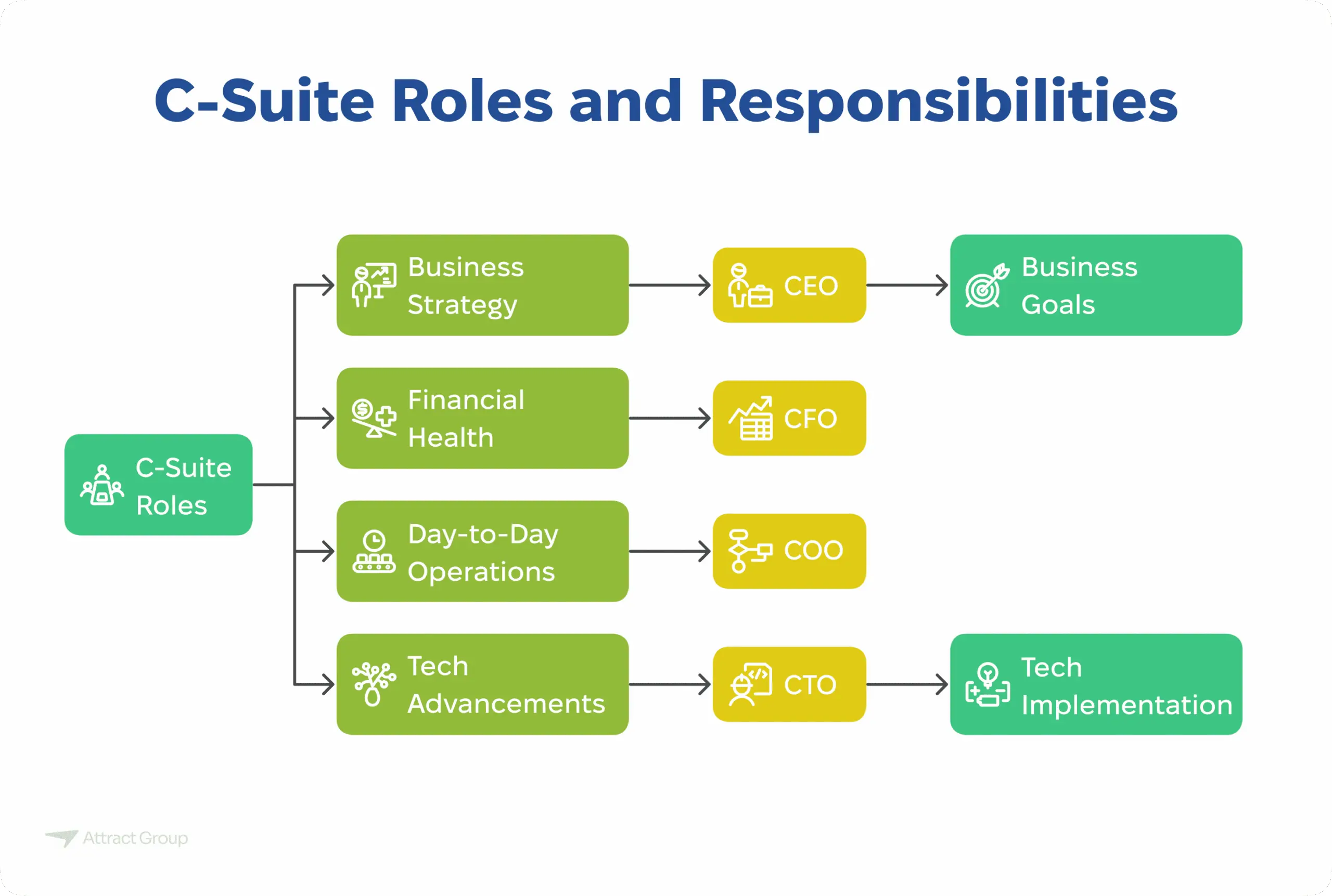
The average salary for a CEO in the U.S. is about $834,500. Others in the C-suite get different pay: CFOs make around $438,800, and COOs get about $490,700 a year. In the tech leadership area, CTOs earn an average of $302,000, while CIOs get around $330,000 yearly. These salary differences point out the various roles and skills needed at the top, including those in human resources who often play a crucial role in shaping the company culture.
What sets C-suite roles apart can also be their educational backgrounds. CEOs and CTOs both bring business insight and tech knowledge. Mostly, CEOs have degrees in business or management, and CTOs have studied IT or computer science. Their studies help them tackle their main jobs; CEOs work on business goals, and CTOs focus on tech to meet those goals.
For those aiming for the C-suite, understanding these roles’ unique and shared qualities is crucial. A well-organized company with clear roles ensures it stays competitive and successful, letting each leader make their best contribution.
Discover how tailored software solutions can streamline your executive operations. Connect with our team to explore custom options for your C-suite.

CEO: Chief Executive Officer
The CEO is the most important person in a company. They make the big plans and ensure the company grows. They’re in charge of leading the company to its goals. They pick the team that helps make decisions. Their main job is to guide the company toward its main goals.
Role and Responsibilities
The chief executive officer creates the company’s big picture plans. Here are some roles and responsibilities of a CEO:
- Set overall corporate vision, mission, and long-term strategy
- Make high-level decisions that shape the company’s future
- Oversee all operations and business activities
- Build and lead the executive team
- Represent the company to external stakeholders (investors, media, public)
- Ensure company compliance with legal and regulatory requirements
- Drive organizational culture and values
Key Skills and Qualifications
- Advanced degree (often MBA) in business or related field
- Extensive leadership experience
- Strong strategic thinking and decision-making abilities
- Excellent communication and interpersonal skills
- Financial acumen and business insight
- Ability to inspire and motivate teams
What Makes a Successful CEO
- Visionary leadership and long-term strategic planning
- Adaptability to changing market conditions
- Strong ethical standards and integrity
- Ability to build and maintain key relationships
- Effective crisis management skills
- Track record of driving growth and profitability
- Embracing innovation and digital transformation
How to Hire a CEO
Finding a CEO means evaluating many candidates thoroughly. To hire a CEO, you may follow the following steps:
Step 1: Define role requirements for this highest-ranking executive.
Step 2: Conduct a thorough search for candidates.
Step 3: Evaluate candidates’ ability to set strategic direction.
Step 4: Perform in-depth interviews and background checks.
Step 5: Make an offer and plan for leadership transition.
COO: Chief Operating Officer
The Chief Operating Officer (COO) is key to an organization’s success. They make the CEO’s ideas happen across the whole business.
Role and Responsibilities
The COO oversees daily business operations, making sure they fit the company’s goals. Other roles and responsibilities include:
- Oversee day-to-day administrative and operational functions
- Implement and execute the company’s business strategy
- Manage and optimize internal processes for maximum efficiency
- Collaborate with the CEO on strategic planning and execution
- Develop and monitor operational policies and procedures
- Ensure operational activities align with the company’s goals
- Manage relationships with key partners and vendors
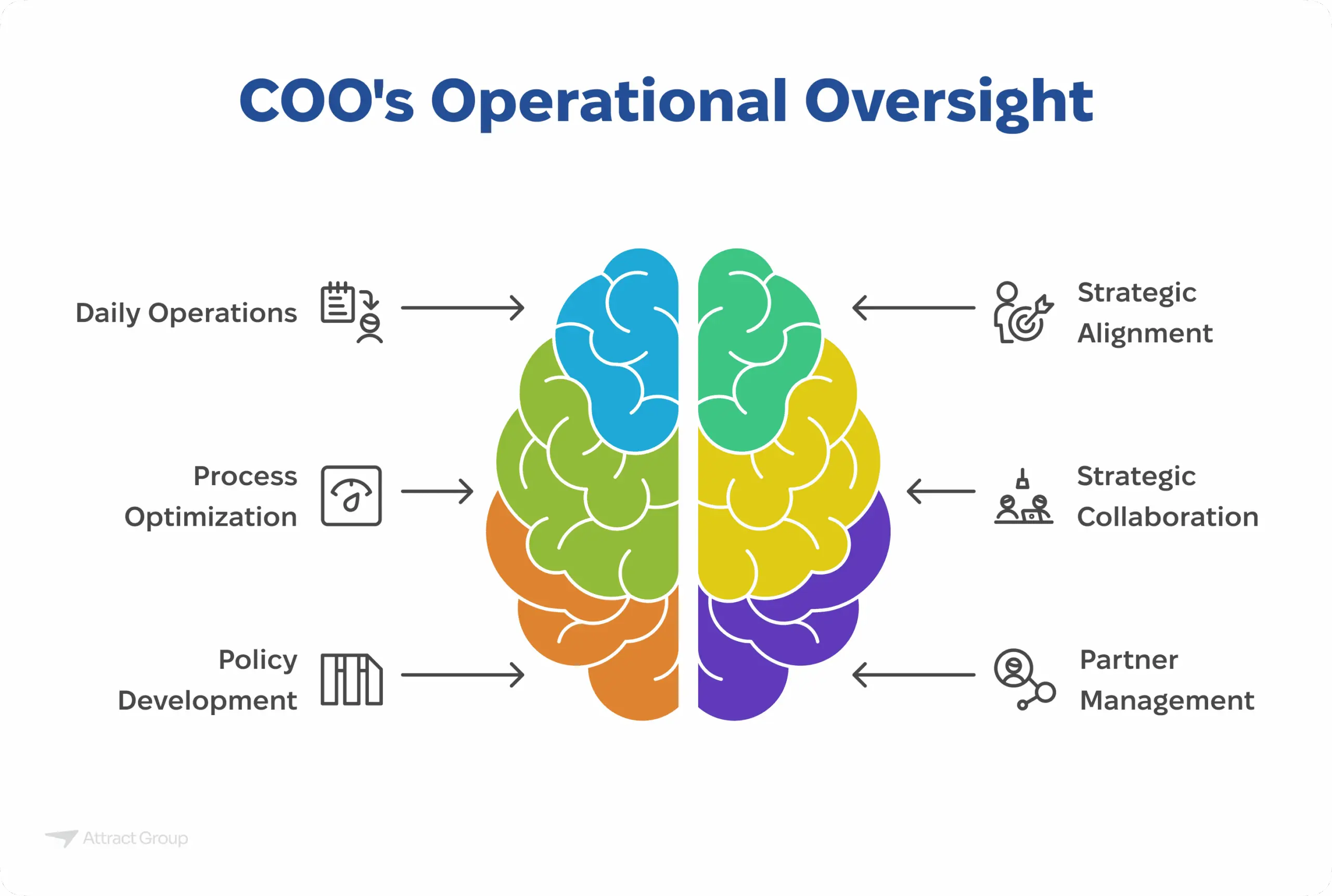
Key Skills and Qualifications
- Advanced degree in business administration or related field
- Extensive operational management experience
- Strong analytical and problem-solving skills
- Excellent organizational and leadership abilities
- Proficiency in process optimization and efficiency improvement
- Deep understanding of industry-specific operations
What makes a Successful COO
- Ability to translate strategy into actionable plans
- Strong project management skills
- Talent for identifying and implementing operational efficiencies
- Excellent team leadership and collaboration abilities
- Data-driven decision-making approach
- Adaptability to rapidly changing business environments
- Proficiency in risk management and compliance
How to Hire a COO
To hire a COO, look for someone with a knack for running things and thinking ahead. Follow these steps:
Step 1: Identify operational needs within the organization.
Step 2: Look for candidates with strong operational experience.
Step 3: Assess their ability to execute strategies effectively.
Step 4: Evaluate their compatibility with the CEO and leadership team.
Step 5: Conduct interviews and check references before making an offer.
CIO: Chief Information Officer The CIO plays a crucial role in guiding a company’s tech plans. They match IT efforts with the company’s main goals. CIOs handle the big IT operations, making sure tech fits well in all business areas. A CIO’s main job is to lead the company’s IT strategy and make sure it supports business aims. Other roles and responsibilities include: In hiring a CIO, look at their tech know-how and their vision for future tech. The other important steps in hiring a CIO include: Step 1: Determine specific IT needs and goals. A Chief Technology Officer (CTO) is key to a company’s tech progress and new product creation. CTO is responsible for improving the company’s tech from the outside, focusing on innovation and bringing new offerings to life. This job needs a mix of strong tech skills and business know-how, so the company’s tech moves match its big plans. CTOs make sure info systems work right, with half of them checking systems run smoothly. Other roles and responsibilities of a CTO may include: To hire a CTO, look for someone who not only gets tech but can also think big about aligning tech with business goals. Follow the below steps for hiring a CTO successfully. Step 1: Define technology goals and innovation needs. The role of a Chief Financial Officer (CFO) is vital in the top management team. They manage all things related to the company’s finances. This includes making smart money decisions and finding the best ways to grow the company’s worth. They offer deep financial insights and a sharp look at the numbers. The CFO has a big job planning the company’s financial future. Main roles and responsibilities of a CFO may include: What Makes a Successful CFO When hiring a CFO, companies check if the person knows their stuff about money. Step 1: Identify financial management needs and goals. The role of a Chief Digital Officer (CDO) came to life because of digital tech’s rise. They are key in guiding digital plans and making sure these plans work well with the company’s goals. They oversee making digital tech a big part of the organization, making these strategies crucial. A CDO’s main job is to create and carry out digital projects that help the company become digitally advanced. Other roles and responsibilities may include: When bringing on a CDO, businesses should look for someone with a history of leading successful digital changes. More companies now see the value of having a CDO for digital growth. Step 1: Define digital transformation objectives. The Chief Marketing Officer (CMO) heads the marketing team. They focus on key elements that help grow the company and its market position. A CMO works toward major marketing goals like building the brand, creating effective marketing plans, engaging customers, and growing market share. Their main roles and responsibilities may include: When hiring a CMO, look for someone with the right skills and qualifications. Step 1: Identify key marketing objectives and challenges. It’s vital to know how C-suite roles differ. This helps us understand how companies make decisions. Each leading role, from the CEO to the CTO, has its own set of tasks. They influence company strategies and daily operations. Understanding the distinct roles and responsibilities of C-suite executives is crucial for effective organizational leadership. Below is a comparison of the key differences between various C-suite roles. The CEO plans the company’s future and sets long-term goals. The COO manages everyday operations and brings the CEO’s vision to life. The CIO looks after information technology, making sure it helps the company’s goals. Meanwhile, the CTO leads in creating new tech products and focuses on innovation. The CEO is the top executive, shaping the company’s future. They set the vision, ensure growth, and speak to stakeholders. Their choices play a big part in whether the company does well or not. Successful COOs have lots of operational experience and often a strong MBA or business background. They’re good at putting plans into action and keeping the company running smoothly every day. This helps in making sure the company’s strategy works out well. A CIO is key for handling tech and data details. They focus on new tech like cloud computing and big data. This is to make sure tech stuff helps the company stay competitive. While a CIO makes sure technology helps with the company’s operations, a CTO looks to the future. They innovate and develop new products. Their job is to drive technological growth. A CFO deals with all things money-related in the company. They plan finances, manage risks, and check on profits. Though they also help make big money decisions, they always report back to the CEO and stakeholders. A CDO leads the charge in digital innovation and strategy. They make sure digital tech is used well across the company. Their goal is to bring measurable change through digital tools. A skilled CMO has marketing or business qualifications and relevant experience. They are experts in strategic marketing, brand building, and using data for decisions. Their focus is on making the brand stronger and connecting with customers. The CEO dreams up the company’s big plans and aims for the future. The COO then takes these plans and makes them real. They handle the daily work to make sure the company’s strategy is done right. Knowing how C-suite roles work together is key to getting how big companies are led. Each role has its own area of expertise. Together, they help the company stand out, stay strong, and succeed.Role and Responsibilities
Key Skills and Qualifications
What makes a Successful CIO
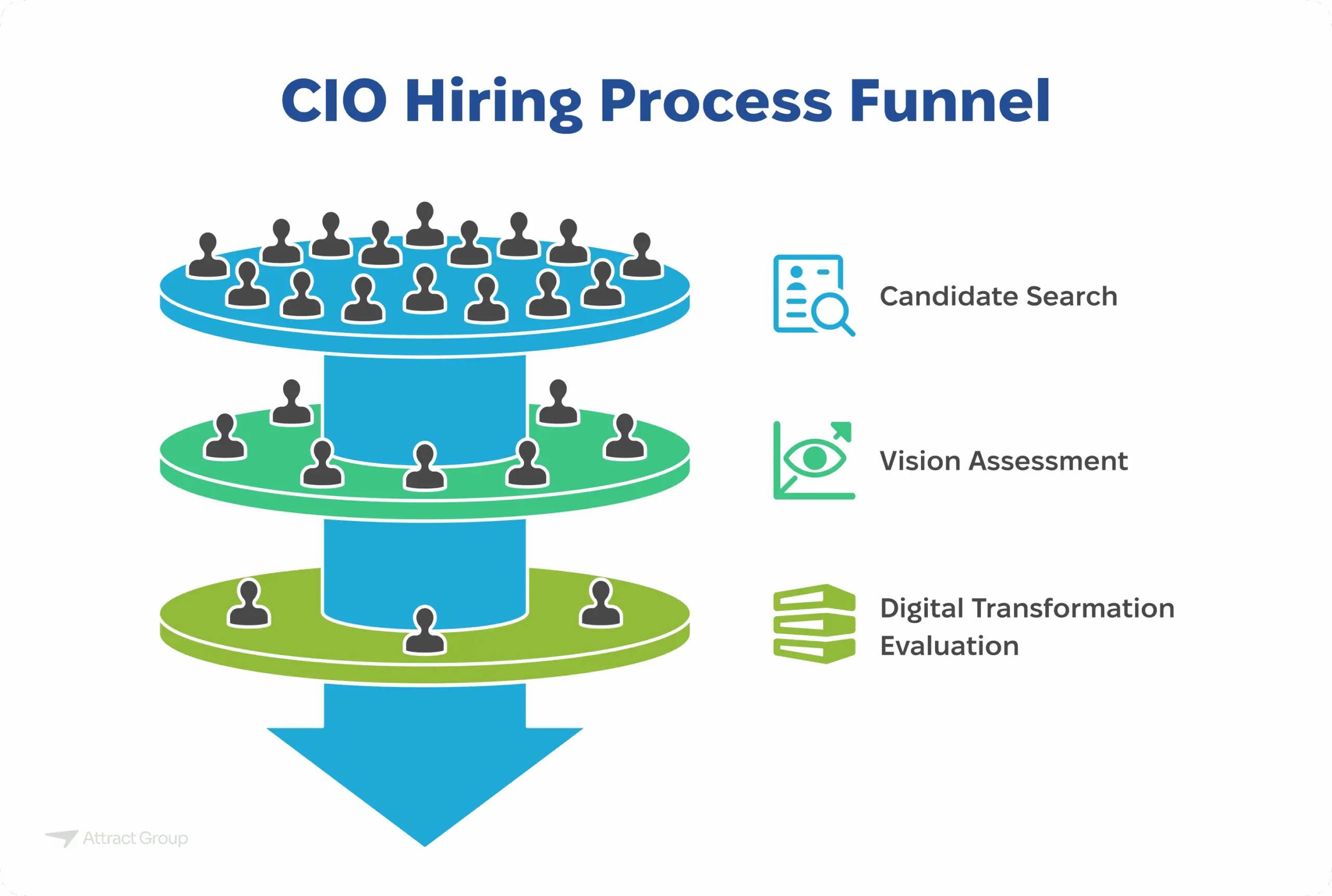
How to Hire a CIO
Step 2: Search for candidates with relevant tech and leadership experience.
Step 3: Assess their vision for aligning IT with business objectives.
Step 4: Evaluate their ability to manage digital transformation.
Step 5: Conduct technical and leadership interviews before hiring.CTO: Chief Technology Officer
Role and Responsibilities
Key Skills and Qualifications
What Makes a Successful CTO
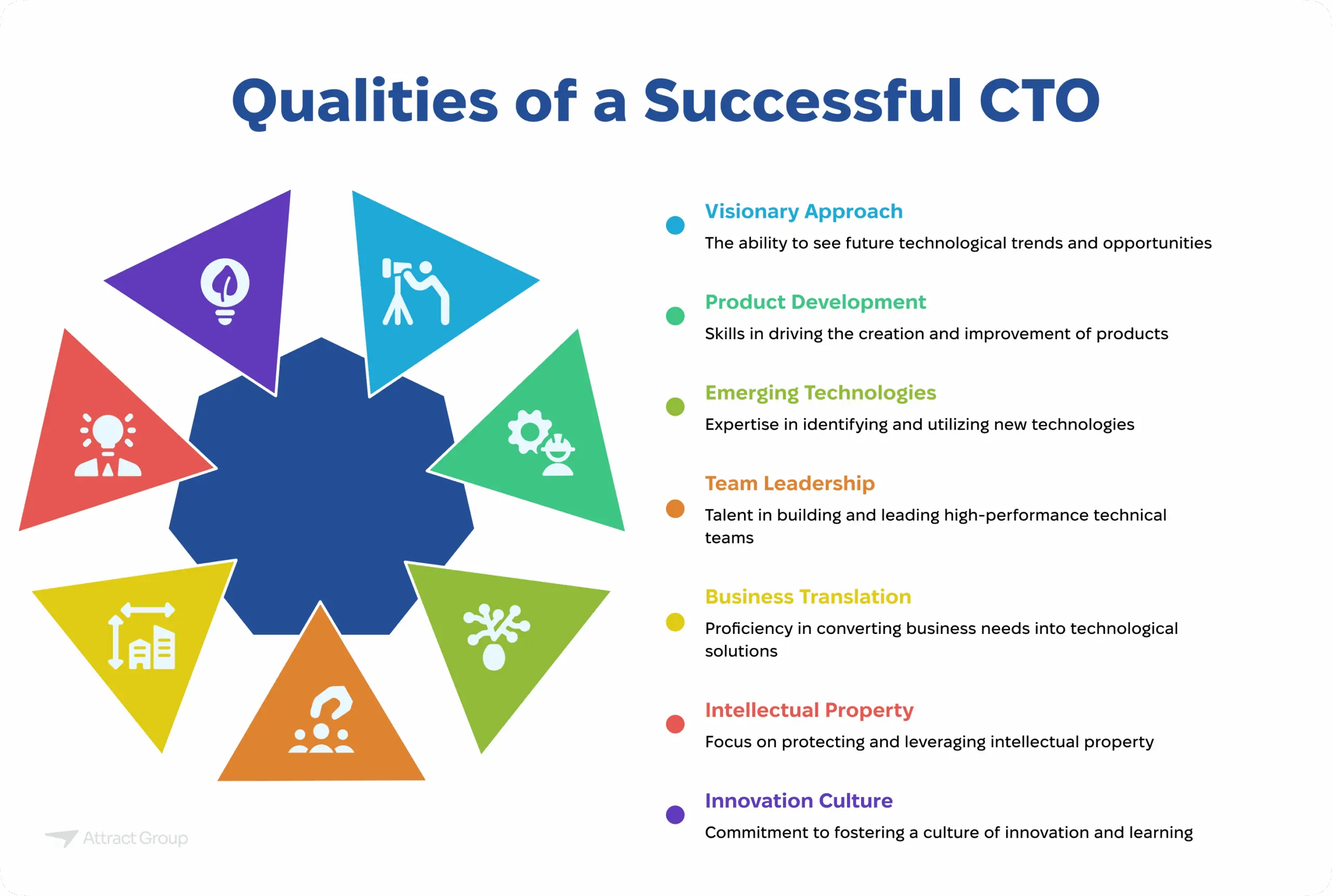
How to Hire a CTO
Step 2: Seek candidates with strong tech backgrounds and vision.
Step 3: Evaluate their ability to drive product development and R&D.
Step 4: Assess their leadership skills and business acumen.
Step 5: Conduct technical interviews and check industry reputation.
Learn how our custom software can address the unique needs of each C-suite role. Our experts are here to help you find the perfect solution.CFO: Chief Financial Officer
Role and Responsibilities
Key Skills and Qualifications
How to Hire a CFO
Step 2: Look for candidates with relevant financial expertise.
Step 3: Assess their strategic thinking and communication skills.
Step 4: Evaluate their experience in financial planning and shareholder relations.
Step 5: Conduct thorough interviews and verify credentials.CDO: Chief Digital Officer
Role and Responsibilities
Key Skills and Qualifications
What makes a Successful CDO
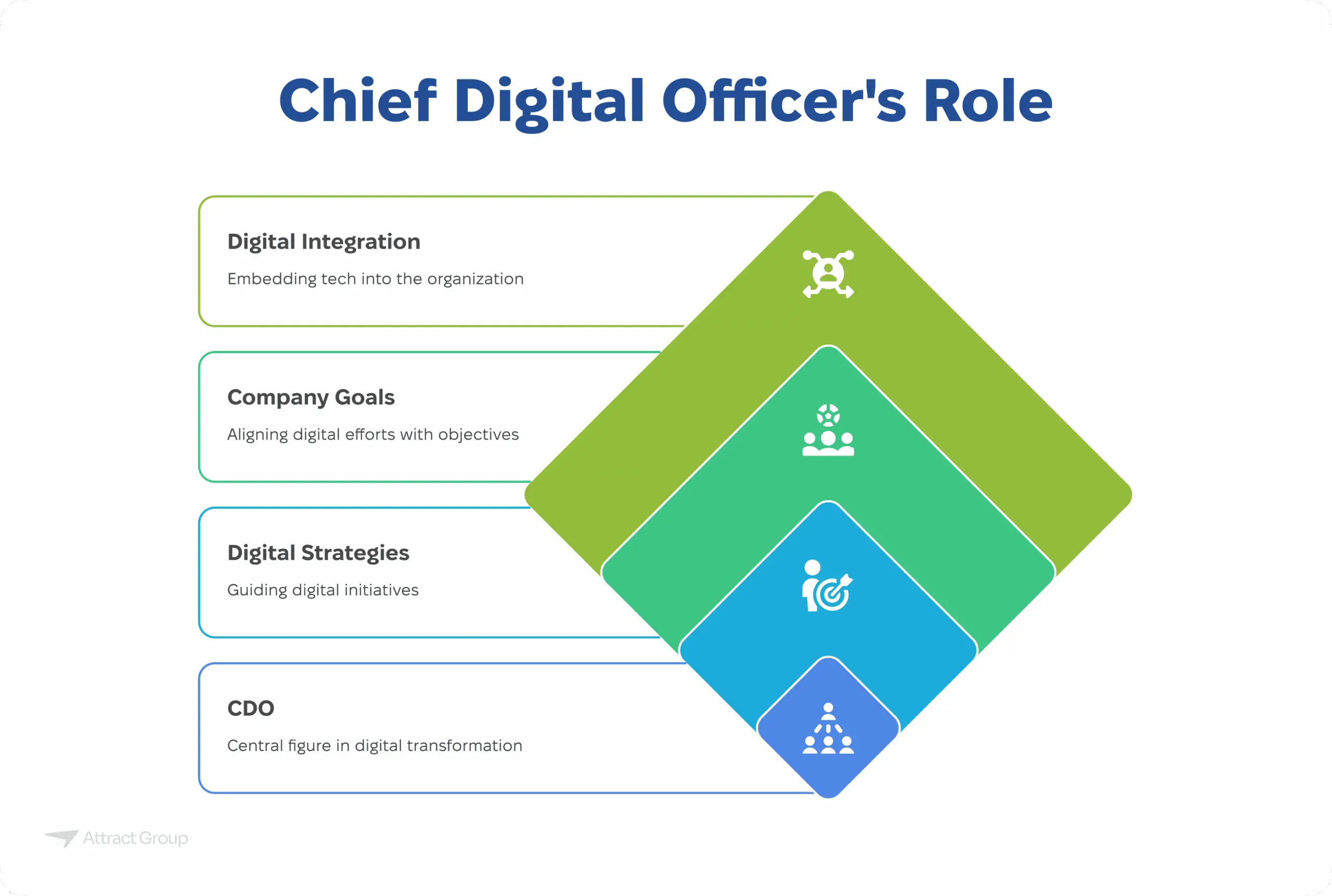
How to Hire a CDO
Step 2: Seek candidates with proven digital strategy experience.
Step 3: Assess their understanding of emerging technologies.
Step 4: Evaluate their ability to drive organization-wide change.
Step 5: Conduct interviews focusing on past digital achievements.CMO: Chief Marketing Officer
Role and Responsibilities
Key Skills and Qualifications
What Makes a Successful CMO
How to Hire a CMO
Step 2: Look for candidates with distinct responsibilities in previous roles.
Step 3: Assess their creative vision and analytical skills.
Step 4: Evaluate their understanding of digital marketing trends.
Step 5: Review the executive’s typical report structure in past positions.Comparing the C-Suite Roles
Comparing C-Suite Roles: Key Differences
Comparison CEO COO CIO CTO CEO vs COO Sets overall vision and strategy; makes final decisions Executes strategy; oversees daily operations Aligns IT strategy with business goals Drives technological innovation and product development CEO vs CIO Develops long-term business strategy; allocates resources Ensures operational efficiency to support strategy Manages IT infrastructure; aligns tech with business objectives Focuses on emerging technologies and their potential applications CEO vs CTO Defines company vision and market positioning Optimizes internal processes and resource allocation Maintains and upgrades existing IT systems Leads R&D efforts; develops new products and technologies COO vs CIO Focuses on overall business operations and efficiency Manages company-wide operations and logistics Oversees IT operations and digital transformation initiatives Explores cutting-edge technologies for future implementation COO vs CTO Ensures current business processes run smoothly Implements and optimizes operational systems Manages enterprise-wide IT systems and security Develops new technologies to enhance products and services CIO vs CTO Approves major tech investments aligned with strategy Ensures tech integration across all operations Focuses on internal IT infrastructure and systems
Concentrates on external-facing technology and innovation
Our experienced team can develop tailored software to enhance your executive team’s efficiency. Start the conversation today!FAQs
What are the key differences between the roles of CEO, COO, CIO, and CTO?
How does a CEO contribute to a company’s success?
What qualifications and skills are essential for a COO?
What makes a CIO vital in today’s business environment?
What distinguishes a CTO from a CIO?
What are the main responsibilities of a CFO?
What role does a Chief Digital Officer (CDO) play within a company?
What qualifications are typically required for a CMO?
How do the roles of CEO and COO differ in terms of strategic focus?
Why is understanding the dynamics of C-suite roles important?










